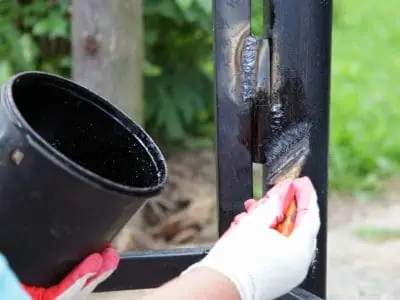Using spray paint to cover up chips and scratches is convenient and fast, but what about the overspray? Spray paint is notoriously difficult to control. But cleaning spray paint from plastic is simple enough if you follow our top techniques.
Knowing how to remove spray paint from plastic will save you money and keep your plastic surfaces looking good for longer.
Key Takeaways
- Identify the paint type: Oil-based paints are harder to remove while acrylic paints can be cleaned with soap and water.
- Removing wet paint: Use a clean rag soaked in warm soapy water for latex-based paint or paint thinner for oil-based paint.
- Removing dried paint: Household items like dish soap, vegetable oil, rubbing alcohol, or nail polish remover can help lift the paint from the surface.
- Natural alternatives: White vinegar, baking soda, hydrogen peroxide, and lemon juice can be used to remove paint from plastic surfaces without chemicals.
Oil-Based Vs. Latex Spray Paint
Cleaning spray paint from plastic can be easy or challenging, depending on the type of paint. Oil-based spray paints are harder to remove than latex paint because you will need a paint thinner or spray paint remover.
If you are painting exterior surfaces, use oil-based paint. For internal spaces, you don’t need oil spray paints. Oil-based formulas, like this Rust-Oleum Enamel Paint, have a higher chemical and solvent makeup, which means they are more robust.
Latex paints are better for interior surfaces because they are water-based, giving off fewer odors and VOCs (volatile organic compounds). As the paint dries, it emits low ozone levels, unlike the higher ozone associated with oil-based paint.
Latex (acrylic) paints simply rub off with soap and water. This is better for the environment because you don’t need nasty chemicals for the cleanup.
How to Remove Spray Paint from Plastic While Wet
It is much easier to deal with paint splatters while wet. It takes less effort to remove it, and you are unlikely to leave visible stains.
If the paint is latex-based, grab a clean rag and soak it in warm soapy water. Wipe it over the spill, and it should lift clean off. If the paint is oil-based, soak a clean rag in either paint thinner or mineral spirits.
If you don’t have those products to hand, use nail polish remover or rubbing alcohol. Wipe the rag over the splatter, and it will come right off. If there are any visible stains, add a few drops of paint thinner to the rag and keep rubbing until the stain vanishes.
Removing Dried Spray Paint from Plastic
Dried paint is more challenging to remove. Surprisingly, many of the techniques involve working with household items. So, how do you remove paint from plastic without scratching? Let’s find out.
With Dish Soap
We all have dish soap in the kitchen, and it is surprisingly effective at removing water-based paints from plastic surfaces. Grab a bucket and fill it with warm water and a few drops of dish soap.
This Dawn Platinum Dish Soap is an excellent product because it is super-concentrated with four times the cleaning power. Dip a clean rag in the soapy water and wring it out so that it is damp rather than soaking wet.
Rub at the splatter, and the paint should start to thin. It may take several attempts, but it will lift off with perseverance.
If you need more elbow power, try using a washing sponge with a scourer. You will need to rub lightly because it may scratch the surface if you are over-vigorous.
With Vegetable Oil
If the stain is starting to dry, it’s time to break out the vegetable oil. It is safe to use and will soften the paint splatter.
Pour a few drops onto a clean rag and rub at the stain vigorously. It starts to break down the paint, and you should see it deteriorate. When the paint starts to lift, use a scraping tool, like this Bates 10-in-1 Tool.
Word Of Caution
Go gentle with the paint scraper, or risk scratching the plastic surface. You should be okay because the paint has softened with the oil but use caution.
When the paint is removed, wipe the surface clean with a dry rag.
With a Paint Scraper
There are several varieties of paint scrapers to choose from. This Bahco 665 Ergonomic model is unique because it has a grab handle to make scraping more comfortable.
Using a paint scraper is one of the most satisfying methods. Start on the outer edge, pressing the blade against the stain. Nothing quite beats seeing the paint lift with every push with the scraper.
Apply gentle pressure, and the blade will lift the paint. Repeat this process until the stain is gone. This technique is only suitable for flat surfaces. You will need a razor blade for contoured surfaces.
With Rubbing Alcohol
Rubbing alcohol is another excellent product to use on stubborn paint stains. It is especially useful if you want to remove the splatter without scratching. This Amazon brand Solimo 99 Percent Isopropyl Alcohol is an excellent example of an affordable product.
Safety First
Rubbing alcohol is highly flammable, so keep it away from naked flames and other heat sources.
Rubbing alcohol removes the paint without damaging the plastic surfaces. Some chemical products can melt plastic, but rubbing alcohol is perfectly safe.
Don a face mask and rubber gloves when working with rubbing alcohol because it gives off strong fumes and can irritate your skin. Pour the alcohol over the stain and rub strenuously until the paint starts to lift.
Persistence is the watchword here. Rub the splatter multiple times and you will clear the stain without scratching.
With Nail Polish Remover
Nail polish remover (sometimes called acetone) is a handy product to keep in the cupboard. Not only will it keep your nails clean, but it also dissolves paint on plastic surfaces.
If you think about what nail polish remover does to your nail polish, imagine what it does to dried paint. Soak a cotton wool ball or clean rag in the acetone and apply it to the stain.
Cotton wool balls are ideal because you can leave them to sit on stubborn splatters while they dissolve the paint.
Rub the stain, and it will begin to lift. When you are satisfied the stain is gone, clean the area with soapy water.
With WD-40
Neat fact: WD-40 literally stands for water displacement 40th formula. How many people knew that? Guaranteed, you’ll be using that piece of trivia in a conversation soon.
Contrary to popular belief, it is not a lubricant but a water displacer that removes dust and debris from several surfaces, including some plastics.
Test a small area to see if your plastic can handle the effects of WD-40. If the answer is yes, then spray it over the stain and wait while it gets to work. After five minutes, wipe the plastic with a clean rag, and the splatter should wipe away.
With Magic Eraser
Magic Eraser is one of those products that most people keep handy for household cleaning and stains. It’s a great choice when cleaning paint splatters from plaster walls, wood, plastic, and even car interiors.
Simply wet the Magic Eraser in a bucket of water to activate the cleaning agent. Squeeze it out and apply the eraser to the paint splatter. You may need to persevere because Magic Eraser takes elbow grease.
Keep working the eraser over the surface until the stain is gone. Now, wipe the surface clean with a dry cloth.
With Goo Gone
Goo Gone is a citrus-based cleaning agent primarily used for cleaning glue and adhesive residue. Before applying Goo Gone, test a small area of the plastic to see if it reacts badly.
If you are satisfied, add the formula to the paint stain, wait eight to 10 minutes, and then wipe the surface clean using a cloth.
With Paint Thinner
Keep In Mind
Paint thinner can harm most plastics if used liberally, so use it sparingly. Dab a few drops onto a clean rag, and rub at the paint splatter. You should see the paint break up and color transfer onto the cloth.
Keep adding paint thinner to the rag and keep rubbing the paint spot. Eventually, the stain will fade.
You might be tempted to pour the thinner on the plastic and leave it to sit for 20 minutes. If you do, perform a spot test first to see if the thinner damages the plastic.
How Do You Remove Paint from Plastic Using Natural Products
If you are uncomfortable using chemicals, you will need to find a natural alternative. Luckily, some household products work effectively at removing plastic paint stains.
White Vinegar
White vinegar is a natural ingredient that removes paint from plastic surfaces. You can dab it on neat for stubborn stains or dilute it with water for lighter stains.
Word Of Warning
When using neat vinegar, open windows to remove the strong odor. Don’t be tempted to heat the vinegar in a pan, as this will melt and warp the plastic.
Baking Soda
Baking soda is another all-natural substance that is effective at removing paint stains. You can mix it with a small amount of water to create a paste and coat the splatter or water it down in a spray bottle.
If you want to increase the cleaning power, add it to your white vinegar and water mix for extra punch.
Hydrogen Peroxide
Hydrogen peroxide is perfectly safe as long as you use the weaker versions, like this Amazon Brand Solimo Peroxide Solution. It only contains 3 percent hydrogen peroxide, so it won’t corrode your plastic surfaces, but it will help to break down the paint.
Pour it over the stain, wait 10 minutes, and wipe it clean with a cloth. You will need gloves for this and a face mask to counteract the fumes.
Lemon Juice
Lemon juice contains natural acids that eat away at the paint. The acids loosen the color, but you will still need to scrub hard. This Citra Solv is a great example of a degreaser containing citrus acids as the primary ingredient.
How Do You Remove Spray Paint From Car Interior?
Try washing the paint stain, especially on upholstery where chemicals may react badly. If that doesn’t work, try using natural ingredients like white vinegar and baking soda. You could also try lemon juice and carpet cleaner for trunk spills.
Paint splatters on dashboards are a little easier to deal with because you can use the same products as you did removing paint from plastic.
Try to steer away from harsh chemicals, like paint thinner or solvents that could react with the plastic inside your car. Always spot test the surface first before applying any treatment to remove paint.
Other substances that should be safe for use on your car interior include:
- Borax.
- Baby oil.
- Mineral spirits.
- Upholstery/ leather cleaner.
FAQs
Plastic Perfection
Cleaning spray paint from plastic involves trial and error. Some products work better on oil-based stains, while others strip water-based splatters. Knowing the type of paint you have is crucial to how you approach the solution.
And don’t be afraid to try more than one method before achieving your goals. Perseverance is the key, so if at first you don’t succeed, try, try again.










